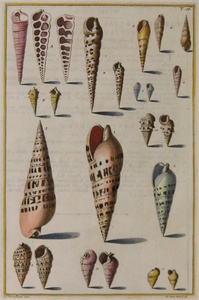| Method | Copper engraving with hand colouring |
| Artist | Pietro Antonio Pazzi after Giuseppe Menabuoni |
| Published | Florence, 1742 |
| Dimensions | Image 360 x 229 mm, Plate 366 x 236 mm, Sheet 433 x 312 mm. |
| Notes |
From Niccolò Gualtieri's Index Testarum Conchyliorum (Index of Mollusc Shells). Niccolò Gualtieri (1688 - 1747) was a medical doctor - acting as physician to Cosmimo III de' Medici - and professor at the University of Pisa. Although primarily a doctor and professor, Gualtieri's avocation was the study of molluscs, and he soon formed a major collection of shells. Whilst cabinets of shells were fashionable amongst court circles, Gualtieri's collection proved to be particularly impressive. It was his collection that the Index Testarum Conchyliorum was based upon, and from this, a system of classification was devised. For each plate, of which Menabuoni and Pazzi created 110, a corresponding list of classifications was produced. Index Testarum Conchyliorum combines scientific observation with aesthetic appreciation, capturing the dynamic interplay of natural forms. Part of Gualtieri's collection remains at the Museum of Natural History and the Territory of Calci, operating under the support of the University of Pisa. Gualtieri also co-founded the first European botany society, the Botanical Society of Florence, in 1716. . Pietro Antonio Pazzi (1706 - 1770) was an Italian engraver, painter, and abbot. Born in Florence, Pazzi studied art under G. Pramontini and Cosimo Mogalli. Pazzi is perhaps best known for his engravings of the series of portraits of painters in the Florence Gallery for A. F. Gori's Museum Florentinum (1731 - 62). Giuseppe Menabuoni (1708 - 1745) was an Italian writer and painter active in Tuscany. |
| Framing | mounted |
| Price | £245.00 |
| Stock ID | 34586 |

